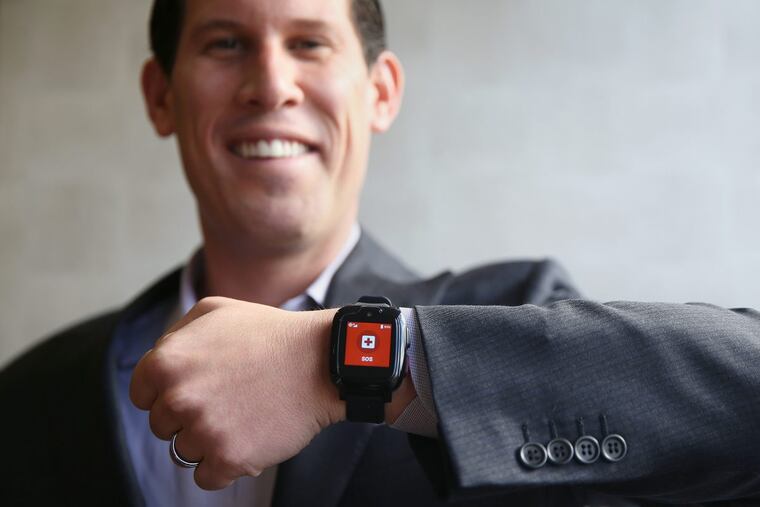Philly-based Medical Guardian targets 'massive' market among elderly for personal alarms
"I've fallen and I can't get up" was the much-mocked catchphrase used to sell the first generation of alert devices. A new device from Philadelphia-based Medical Guardian aims to change that.

Is it time for more senior citizens to embrace personal alarms?
The devices, formally known as Personal Emergency Response Systems (PERS), let people age at home by providing a direct phone lifeline to a call center. If the wearer falls or is stricken by a heart attack, a push of a button can immediately summon help.
But thanks to stigma and clunky design, the devices have never really caught on.
"The penetration in the market is only 3 to 5 percent," said Geoff Gross, CEO of Philadelphia-based Medical Guardian. "And the biggest reason is perception."
Gross believes he can turn around the industry.
In March, his company will launch the Freedom Guardian, a smart watch for seniors. It's a sleek and inconspicuous update on the personal alarm device. Gross is eyeing part of what Grand View Research Inc. says will be an $11.1 billion worldwide market for personal alarms by 2025.
"Our expectation is that this will broaden the market," said Gross, who started Medical Guardian from his Center City apartment in 2005. "People who wouldn't otherwise use a medical alert system can wear this every day."
About 12.5 million seniors live alone, according to census data. The baby boom population will grow to 61.3 million by 2029 when the youngest boomers turn 65.
The Freedom Guardian, which is slightly thicker than an Apple Watch, has a two-day battery life and can be worn while bathing. The target consumers are in their early 70s.
The device is simpler than its high-tech cousin, largely because the current population of seniors are not digital natives, Gross said.
"Our average customers don't have smartphones, and many don't have cars or they've had them taken away," Gross said. "Our customers can get easily overwhelmed by technology."
The Freedom Guardian features oversize icons and simple scrolling, and is "very loud," Gross said. It can call for Lyft, translate text messages to voice (and vice versa), and remind the wearer to take medications. It has built-in GPS that can help guide emergency workers to the wearer's location.
The device can also be set up to alert a caregiver when the wearer unexpectedly leaves the property or loses contact with WiFi.
Though the device is essentially a cellphone built into a watch, calls can only be placed to the monitoring center for help or transportation. Anything else would drain the battery too fast, said Matt Guerrieri, Medical Guardian's vice president of marketing.
"We wanted something easy and aesthetically pleasing," Guerrieri said. "We didn't give them what they didn't need."
"I've fallen and I can't get up" was the much-mocked catchphrase used to sell the first generation of alert devices. Those gadgets, the best known of which was introduced three decades ago and marketed by LifeAlert, were heavy gray plastic pendants with an alarm button the size of a doorbell.
The LifeAlert slogan was unforgettably catchy. Crowed by a distressed older woman in cheaply produced TV commercials, its lasting power cast a stigma that kept many from adopting the devices.
"Most elders don't see themselves as particularly vulnerable. They're willing to take the risk of a fall rather than wear something that flags them as disabled," said Diane Mahoney, a gerontologist at MGH Institute of Health Professions in Boston.
The sentiment was echoed in Philadelphia. "Older people want to retain their dignity, even from going to cane to a walker," said Anuradha Paranjape, professor at Lewis Katz School of Medicine at Temple University.
An alarm device is of no use if someone refuses to wear it, Paranjape said.
"In practice you want to look normal for as long as it takes," Paranjape said. "And something dangling around the neck can be difficult to accept."